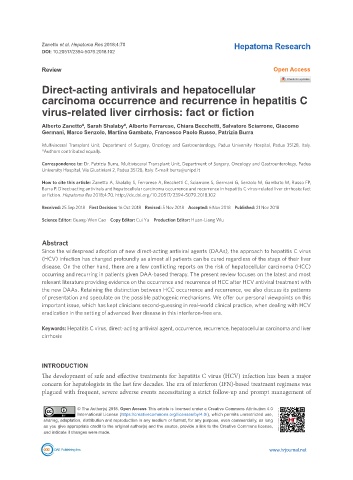Page 781 - Read Online
P. 781
Zanetto et al. Hepatoma Res 2018;4:70 Hepatoma Research
DOI: 10.20517/2394-5079.2018.102
Review Open Access
Direct-acting antivirals and hepatocellular
carcinoma occurrence and recurrence in hepatitis C
virus-related liver cirrhosis: fact or fiction
#
#
Alberto Zanetto , Sarah Shalaby , Alberto Ferrarese, Chiara Becchetti, Salvatore Sciarrone, Giacomo
Germani, Marco Senzolo, Martina Gambato, Francesco Paolo Russo, Patrizia Burra
Multivisceral Transplant Unit, Department of Surgery, Oncology and Gastroenterology, Padua University Hospital, Padua 35128, Italy.
# Authors contributed equally.
Correspondence to: Dr. Patrizia Burra, Multivisceral Transplant Unit, Department of Surgery, Oncology and Gastroenterology, Padua
University Hospital, Via Giustiniani 2, Padua 35128, Italy. E-mail: burra@unipd.it
How to cite this article: Zanetto A, Shalaby S, Ferrarese A, Becchetti C, Sciarrone S, Germani G, Senzolo M, Gambato M, Russo FP,
Burra P. Direct-acting antivirals and hepatocellular carcinoma occurrence and recurrence in hepatitis C virus-related liver cirrhosis: fact
or fiction. Hepatoma Res 2018;4:70. http://dx.doi.org/10.20517/2394-5079.2018.102
Received: 25 Sep 2018 First Decision: 16 Oct 2018 Revised: 5 Nov 2018 Accepted: 6 Nov 2018 Published: 21 Nov 2018
Science Editor: Guang-Wen Cao Copy Editor: Cui Yu Production Editor: Huan-Liang Wu
Abstract
Since the widespread adoption of new direct-acting antiviral agents (DAAs), the approach to hepatitis C virus
(HCV) infection has changed profoundly as almost all patients can be cured regardless of the stage of their liver
disease. On the other hand, there are a few conflicting reports on the risk of hepatocellular carcinoma (HCC)
occurring and recurring in patients given DAA-based therapy. The present review focuses on the latest and most
relevant literature providing evidence on the occurrence and recurrence of HCC after HCV antiviral treatment with
the new DAAs. Retaining the distinction between HCC occurrence and recurrence, we also discuss its patterns
of presentation and speculate on the possible pathogenic mechanisms. We offer our personal viewpoints on this
important issue, which has kept clinicians second-guessing in real-world clinical practice, when dealing with HCV
eradication in the setting of advanced liver disease in this interferon-free era.
Keywords: Hepatitis C virus, direct-acting antiviral agent, occurrence, recurrence, hepatocellular carcinoma and liver
cirrhosis
INTRODUCTION
The development of safe and effective treatments for hepatitis C virus (HCV) infection has been a major
concern for hepatologists in the last few decades. The era of interferon (IFN)-based treatment regimens was
plagued with frequent, severe adverse events necessitating a strict follow-up and prompt management of
© The Author(s) 2018. Open Access This article is licensed under a Creative Commons Attribution 4.0
International License (https://creativecommons.org/licenses/by/4.0/), which permits unrestricted use,
sharing, adaptation, distribution and reproduction in any medium or format, for any purpose, even commercially, as long
as you give appropriate credit to the original author(s) and the source, provide a link to the Creative Commons license,
and indicate if changes were made.
www.hrjournal.net

